Great Red Spot Heats Jupiter’s Upper Atmosphere

Artists’ concept of the mechanism of heating from the Great Red Spot. Turbulent atmospheric flows above the storm produce both gravity waves and acoustic waves. Gravity waves are much like how a guitar string moves when plucked, while acoustic waves are compressions of the air (sound waves). Heating in the upper atmosphere 500 miles above the storm is thought to be caused by a combination of these two wave types ‘crashing’ like ocean waves on a beach. Credit: Art by Karen Teramura, UH IfA with James O’Donoghue and Luke Moore
Researchers from Boston University’s Center for Space Physics, using data from the Infrared Telescope Facility on Maunakea, report today in Nature that Jupiter’s Great Red Spot may provide the mysterious source of energy required to heat the planet’s upper atmosphere to the unusually high temperatures observed.
Sunlight reaching Earth efficiently heats Earth’s atmosphere at altitudes well above the surface—even at 250 miles high, for example, where the International Space Station orbits.
Jupiter is over five times more distant from the sun, and yet its upper atmosphere has temperatures, on average, comparable to those found at Earth. The sources of the non-solar energy responsible for this extra heating have remained elusive to scientists studying processes in the outer solar system.
“With solar heating from above ruled out, we designed observations to map the heat distribution over the entire planet in search for any temperature anomalies that might yield clues as to where the energy is coming from,” explained Dr. James O’Donoghue, research scientist at BU, and lead author of the study.
Astronomers measure the temperature of a planet by observing the non-visible, infra-red light it emits.
To map this emission from Jupiter, the team used the Infrared Telescope Facility on Maunakea, operated by NASA and the University of Hawaiʻi. The visible cloud tops we see at Jupiter are about 30 miles above its rim; the IR emission used by the BU team came from about 500 miles higher. When the BU observers looked at their results, they found high altitude temperatures much larger than anticipated whenever their telescope looked at certain latitudes and longitudes in the planet’s southern hemisphere.
“We could see almost immediately that our maximum temperatures at high altitudes were above the Great Red Spot far below—a weird coincidence or a major clue?” O’Donoghue added.
Jupiter’s Great Red Spot is one of the marvels of our solar system. Discovered within years of Galileo’s introduction of telescopic astronomy in the 17th Century, its swirling pattern of colorful gases is often called a “perpetual hurricane.”
The GRS has varied is size and color over the centuries, spans a distance equal to three earth-diameters, and has winds that take six days to complete one spin. Jupiter itself spins very quickly, completing one revolution in only ten hours.
“The Great Red Spot is a terrific source of energy to heat the upper atmosphere at Jupiter, but we had no prior evidence of its actual effects upon observed temperatures at high altitudes,” explained Dr. Luke Moore, a study co-author and research scientist in the Center for Space Physics at BU.
Solving an “energy crisis” on a distant planet has implications within our solar system, as well as for planets orbiting other stars. As the BU scientists point out, the unusually high temperatures far above Jupiter’s visible disk are not unique. The dilemma also occurs at Saturn, Uranus and Neptune, and probably for all giant exoplanets outside our solar system.
“Energy transfer to the upper atmosphere from below has been simulated for planetary atmospheres, but was not supported by observations,” O’Donoghue said. “The extremely high temperatures observed above the storm appear to be the ‘smoking gun’ of this energy transfer, indicating that planet-wide heating is a plausible explanation for the ‘energy crisis.'”
The authors conclude that the storm in the Great Red Spot produces acoustic waves of energy that heat the upper atmosphere—an effect that has also been observed over the Andes Mountains right here on Earth.
The observations reported today were funded by NASA, and analyzed by O’Donoghue and Moore in collaboration with colleagues Thomas Stallard and Henrik Melin from the University of Leicester in the UK. The data were taken in December 2012 using the SpeX spectrometer on the NASA IRTF on Maunakea.
The NASA Infrared Telescope Facility, a 3.0-meter infrared telescope dedicated to planetary science, is operated by the University of Hawaiʻi IRTF under contract NNH14CK55B with the National Aeronautics and Space Administration.
The Institute for Astronomy at the University of Hawaiʻi at Mānoa conducts research into galaxies, cosmology, stars, planets, and the sun.
Its faculty and staff are also involved in astronomy education, deep space missions, and in the development and management of the observatories on Haleakalā and Maunakea. The Institute operates facilities on the islands of Oʻahu, Maui, and Hawaiʻi.
https://youtube.com/watch?v=AhDJV8QuQ_E
Jupiter from the NASA Infrared Telescope Facility and SpeX instrument. Bright regions at the poles result from auroral emissions; the contrast at low- and midlatitudes has been enhanced for visibility. Great Red Spot (GRS) emissions at midlatitudes can be seen moving under the slit from left to right. The vertical dark line in the middle of the image indicates the position of the spectrometer slit which splits up the light from Jupiter like a prism. Image shown is taken from the slit (slit-jaw imaging) using the “L-filter” (3.13 – 3.53 μm). Credit: James O’Donoghue, Luke Moore and NASA Infrared Telescope Facility (IRTF)












